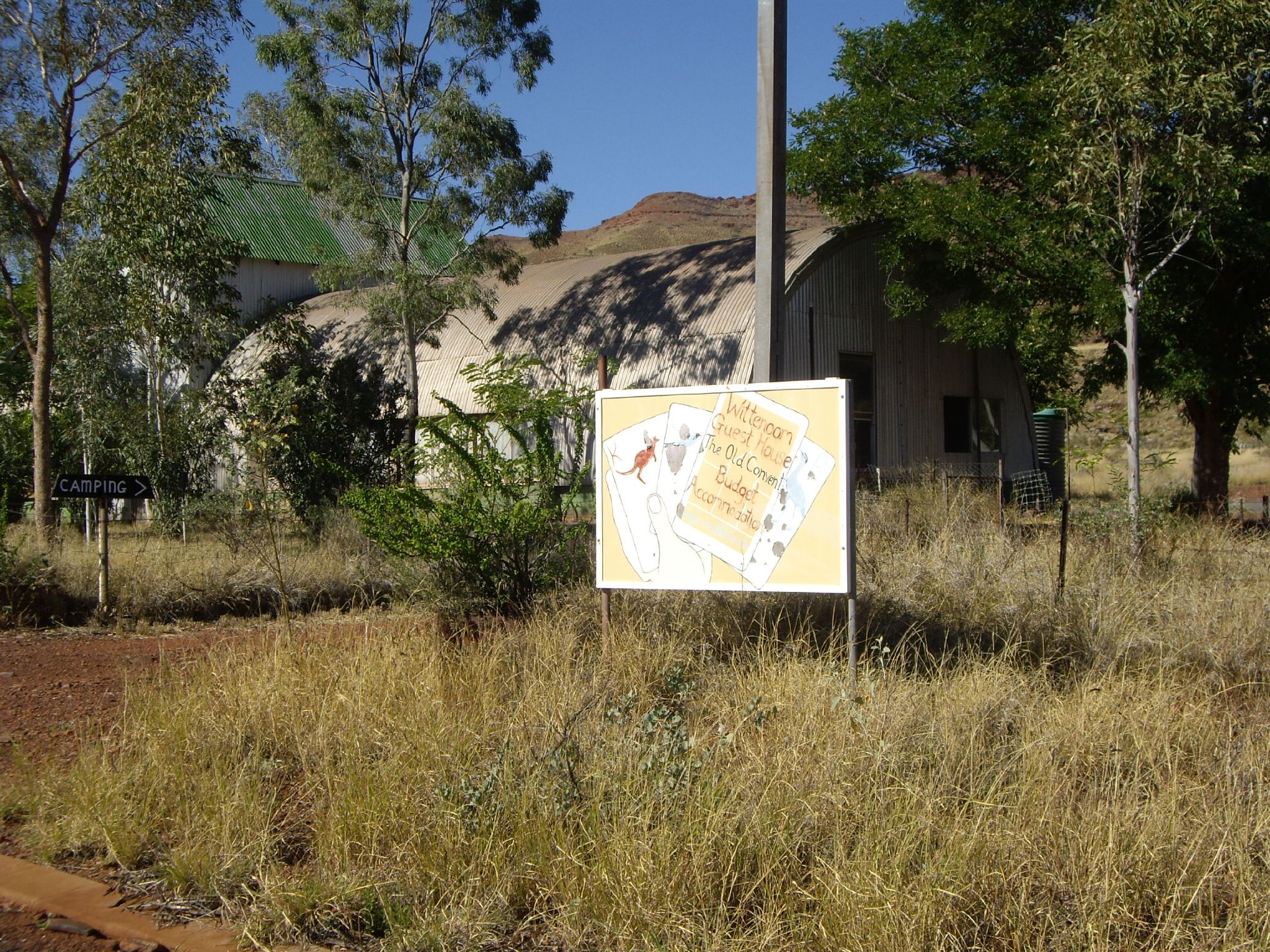- Wittenoom, Western Australia
Infobox Australian Place | type = town
name = Wittenoom
state = wa

caption = Wittenoom
lga = Shire of Ashburton
postcode =
pop = 8-10
est = 1930s
elevation=
maxtemp = 32.8
mintemp = 19.7
rainfall = 453.7
stategov =
fedgov =
dist1 = 241
location1= Newmancoord|-22.244|118.335|type:city(10)_region:AU-WA_scale:30000|format=dms|display=titleWittenoom is a town in the
Pilbara region ofWestern Australia about 1,106 kilometres (687 mi) north-northeast of Perth. During the 1950s, Wittenoom was the Pilbara's biggest town, but was shut down in 1966 due to health concerns fromasbestos mining at the nearby Wittenoom Gorge.Today it is a
ghost town with approximately 8 residentscite web|url=http://www.abc.net.au/news/newsitems/200612/s1817729.htm|title=Govt to remove Wittenoom's town status|work=ABC News Online|accessdate=2006-12-23] who receive no government services. In December 2006, theGovernment of Western Australia announced that the town would be degazetted, and in June 2007, Jon Ford, the Minister for Regional Development, announced that the townsite status had officially been removed. The town's name was removed from official maps and road signs and theShire of Ashburton is able to close roads that lead to contaminated areas.History
Wittenoom was named by
Lang Hancock afterFrank Wittenoom (1855-1939) who was his partner in the nearby Mulga Downs Station. The land around Wittenoom was originally settled by Frank Wittenoom's brother, politician Sir Edward Horne Wittenoom. [LandInfo WA|c|W|2007-09-10]Hancock discovered Wittenoom Gorge in the early 1930s and in 1937 started mining
crocidolite (commonly known as blue asbestos) there. In 1943 the mine was sold to aCSR Limited subsidiary,Australian Blue Asbestos Pty Ltd. By the late 1940s, there was a need for a nearby townsite to house the mine workers and their families, and this was gazetted in 1950. The following year CSR requested the town name be changed to Wittenoom Gorge, and in 1974 it was changed back to Wittenoom.From 1950 until the early 1960s Wittenoom was Australia's only supplier of asbestos with 161,000 tonnes being mined. During that time, 20,000 people lived and worked in Wittenoom. Since then, over 1,000 people have died from asbestos-related diseases including
asbestosis ,lung cancer andmesothelioma . TheNational Health and Medical Research Council estimates that the final death toll will eventually rise to over 2,000. [cite web|url=http://www.safetyline.wa.gov.au/institute/level2/course21/lecture95/l95_07.asp|title=Chronology of events|work=Worksafe|accessdate=2006-05-09]The 1990
Midnight Oil song, Blue Sky Mine, was inspired by the town and its mining industry, [cite web |url=http://www.songfacts.com/detail.php?id=3992 |title=Blue Sky Mine by Midnight Oil |publisher=Songfacts |accessdate=2007-09-10] as were "He Fades Away" and "Blue Murder" byAlistair Hulett . The town and its history are also featured in the novelDirt Music byTim Winton .A small number of residents still remained in early 2006, defying the
Government of Western Australia 's removal of services and stated intention to demolish the town. On30 June 2006 , the Government turned off the power grid to Wittenoom. Between May 2006 and November 2006, three residents took up the government's offer to buy their houses for up to A$39,804, plus an additional solatium of 10% and $10,000 relocation costs.Current situation
A report by consultants GHD and Parsons Brinkerhoff in November 2006 evaluated the continuing risks associated with asbestos contamination in the town and surrounding areas and classed the risk to visitors as medium and to residents as extreme. In December 2006, Minister for the Pilbara and Regional Development Jon Ford announced that Wittenoom's status as a town would be removed, and in June 2007, he announced that the townsite status was officially removed. He also encouraged the remaining residents to accept the Government's relocation offer.
Both the Department of Health and an accredited contaminated sites auditor reviewed the report, with the latter finding that the detected presence of free asbestos fibres in surface soils from sampled locations presented an unacceptable public health risk. The auditor recommended that the former townsite and other impacted areas defined in the report be classified as "Contaminated - Remediation Required". The Department of Environment and Conservation subsequently classified Wittenoom as a contaminated site under the Contaminated Sites Act 2003 on
28 January 2008 . [cite web|url=https://secure.dec.wa.gov.au/contSites/index.cfm?MODULE=publicSearch|title=Search for Known Contaminated Sites|author=Department of Environment and Conservation|accessdate=2008-02-15] A Steering Committee that includes several Government departments meets regularly to discuss the continuing stages of closure of the area.However, opinion is not unanimous on the danger posed.
Mark Nevill , a geologist and former Labor MLC for the Mining and Pastoral district, said in an interview in 2004 that the asbestos levels in the town were below the detection level of most equipment, and the real danger is located in the gorge itself which contains the mine tailings. Residents operate a camping ground, guesthouse and gem shop for passing tourists. [cite news|url=http://www.abc.net.au/7.30/content/2004/s1259219.htm|title=Wittenoom's diehard residents stay put|last=O'Donnell|first=Mick|work=The 7.30 Report |date=6 December 2004 |accessdate=2008-02-15]Wittenoom is close to a number of spectacular gorges in the
Hamersley Range s andKarijini National Park .References
External links
* [http://www.wa.gov.au/wittenoom Wittenoom Information] (Western Australian Government)
* [http://asbestosdiseases.org.au/asbestosinfo/wittenoom_tragedies.htm The Asbestos Disease Society of Australia]
* [http://www.abc.net.au/7.30/content/2004/s1259219.htm Wittenoom's diehard residents stay put] , 7:30 Report (ABC),2004-12-06
Wikimedia Foundation. 2010.
